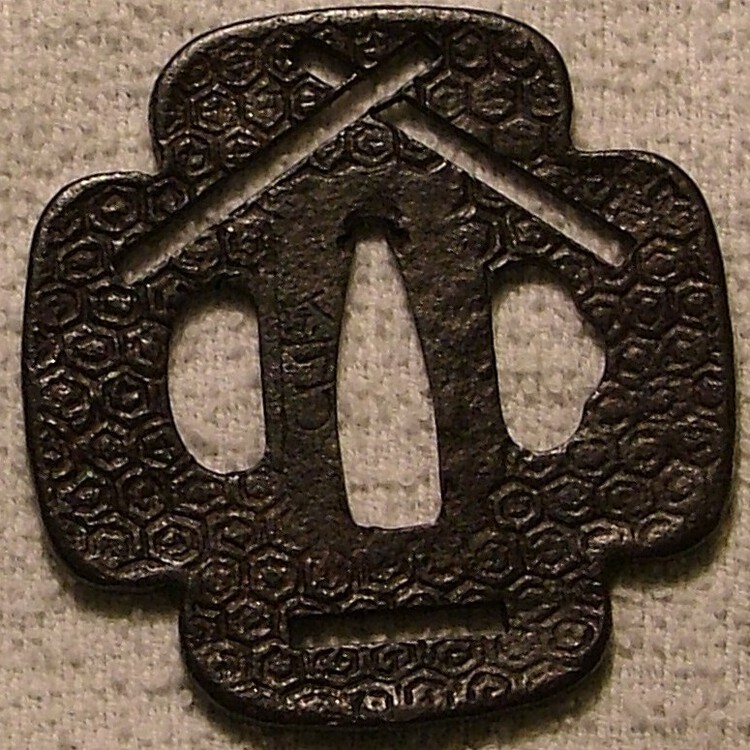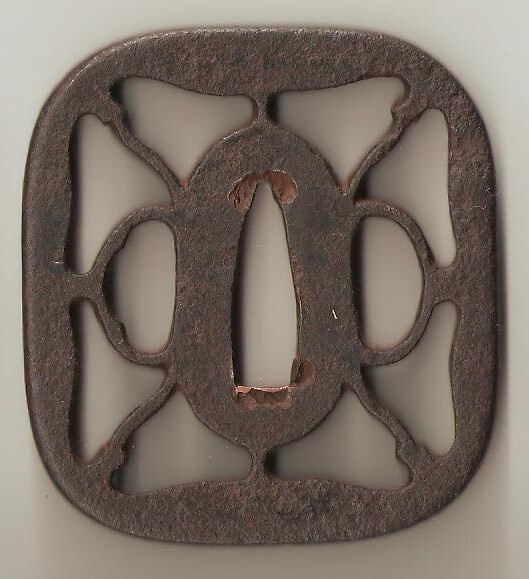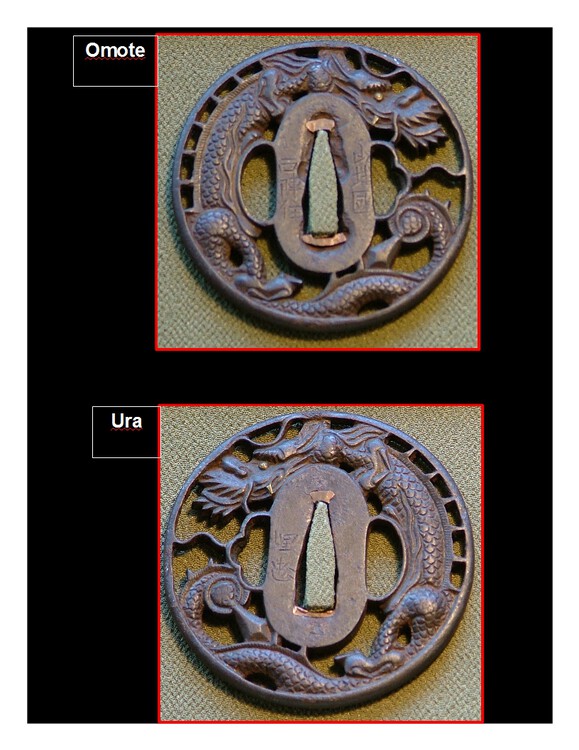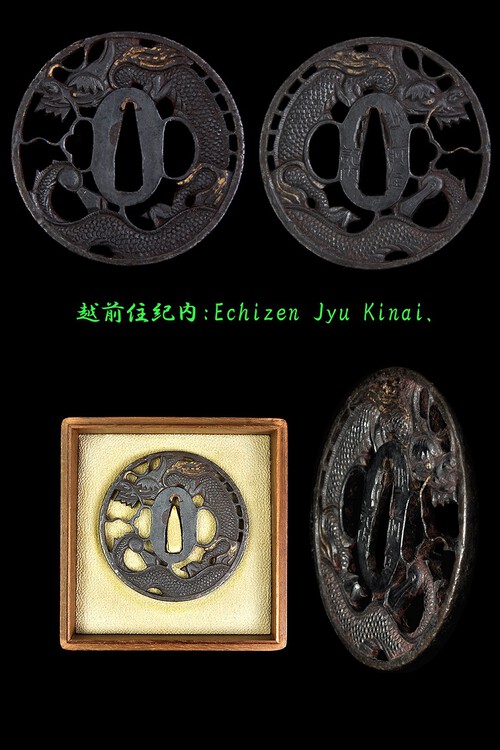-
Posts
2,873 -
Joined
-
Last visited
-
Days Won
3
Content Type
Profiles
Forums
Events
Store
Downloads
Gallery
Everything posted by Soshin
-
Thanks John. I did a quick Google search using the terms "Kaneko" and "Choshu" and came up with these tsuba from a Christies auction lot. Here is the URL: http://www.christies.com/LotFinder/lot_details.aspx?intObjectID=4004105. I would say that the tsuba pictured in the lot are classic Choshu Kinko and likely belong to the Choshu line Reinhard found. They look very different then the current tsuba in question. Does anyone think the mei could have been altered when the iron insert on kozuka hitsu-ana was added? I noticed that the insert is a little bit ticker then the remainder of the tsuba in that area. Yours truly, David S.
-
Hi Reinhard, Thanks for the information. Here is a higher resolution photograph of the tsuba under normal light. The mei is I think a little easier to read in the photograph. I was generally agreeing with Skip's attribution to the Myochin school based upon the kokuin, placement of ko-sukashi above and below the seppa-dai, the very dark blackish brown color of the patina, and the shape of the mimi. The thickness is also characteristic of a earlier Myochin at 0.3 cm at the seppa-dai and 0.4 cm at mimi. Later Myochin tsuba of the middle to late Edo period would be much thicker. I wouldn't describe this tsuba as being Choshu like. Does anyone know of a Myochin armor maker using the Kaneko (金子) name around the Momoyama or early Edo periods who also made tsuba? Or any Myochin armor makers that would use the Kane (金) as the first kanji in their name? Thanks again for all the help. Yours truly, David S.
-
Hello Translation Assistance Forum, This is my first post of this forum on the Nihonto Message Board. I have what I think is a Momoyama period Myochin tsuba that that has a mei that is difficult to read. This I find is often the case with Momoyama tsuba that are signed. The tsuba was once owned by Skip Holbrook that I purchased on the message board. Skip's notes state the following: Well I agree about the school and time period comparing it to other works with shinsa papers but as for the mei I don't think it is signed Nobuiye (信家). From what I can determine as I often help people with translations is that the first Kanji is Kane (金) the second Kanji I am not sure on. This second Kanji character might be stylized in some way making it hard to read. This is why I am posting scans of the tsuba which clearly displays the mei. If you need me to post some higher resolution scans or photos of mei please let me know. I would just like the translation for my own research notes as I really like the tsuba and will not be selling anytime soon. Thank you so much for you help. Yours truly, David S.
-
I think all of the tsuba are real, antique, and dating to the Edo period. I also agree that the tsuba are a pit pricey given the current exchange between the US Dollor and the Japanese Yen and the current market. I have of recently shifted my purchases from Japan were I started to the USA. Next year I am also going to try to make it to more show in the USA as well as deepen my research of tosogu. Thanks for sharing photos of the tsuba for sale in Japan. Yours truly, David S.
-

Dote tsuba Auction ends 28th November
Soshin replied to Henry Wilson's topic in Auctions and Online Sales or Sellers
My impression of this piece is that it likely a Edo period Katchushi tsuba. I come to this conclusion based up it thickness, overall size, and style of rim. The dote mimi and overall thickness and small size is commonly seen in Edo period Katchushi tsuba. Just my opinion. Overall I like the tsuba. Thanks for sharing Henry :D Yours truly, David Stiles -
Merry Christmas Henry! I am more of a iron tsuba person but what a wonderful early Kagamishi tsuba. Thanks for posting detail information about it. Yours truly, David S.
-
I would also agree with James. Both tsuba are cast copies one is iron and the other is copper and likely date to the Showa period and are therefore vintage and not antique. There are frequent motifs and themes copied in antique tsuba as well. I have a Owari Sukashi tsuba from the Momoyama period that is of a sun family crest motif that I think is a antique copy of a similar sun family crest motif done in a Muromachi period Ko-Katchushi tsuba. I have also seen real antique tsuba that have the same motif done in different school styles as well. Just my two cents. Thanks for the interesting topic of buyer beware eBay (aka. crime-bay). Yours truly, David S.
-
Hi Keith, I don't think that out of focus feature is a tekkotsu on the mimi. I would say that it more likely a casing flaw or some very heavy rust. A quick trick to tell is to use some hard wood, dry bamboo, bone, or horn and see if it comes of with some rubbing. If it is rust it would start to wear off if it is a iron casting flaw or a tekkotsu it would not be effected by the rubbing. It might not be worth it as the tsuba is likely case and any iregulaties in the surface of the rim are the result iron casting flaw. I purchased one cast tsuba and I returned to where it came eBay. I was just nice enough to say that it was cast in the item description when I listed. Just my two cents. Thanks for sharing and the discussion. Yours truly, David S.
-
Hi Keith, Could you post some photos of the actives at the rim and hitsuana of the tsuba you describe on your post? If you can't I fully understand as it isn't really easy to photograph such fine detail. For the tsuba in question I have seen this motif frequently on tsuba listed on eBay. Yes before anyone asks I am still spending time looking for a "diamond in the rough" so to speak on eBay. The quality as Eric states is fairly poor in my opinion as well. The tsuba also shows some condition issues in regards to red rust around the dragon design that are independent of the quality. Yours truly, David S.
-
This is generally true for Kanayama tsuba. The sukashi design is often turned on their axis if I remember correctly. I would say that Henry's fine Kanayama school tsuba has a very similar theme but the method of execution is very different. I also find it interesting in the post linked by Henry that their was also a debate if the design was butterflies/moths or lotus leaves. Yours truly, David S.
-
Interesting idea Ford once I did some thinking about it and also did some searching on the internet of photographs for lotus leaves. Here is a good photograph of lotus leaves for reference. The interesting thing is both the leaves and stems are radiating out from the seppa-dai. I wonder if anyone knows of a tsuba with a similar lotus leaves done in kage-sukashi (影絵透) and the lotus stems done in Ji-sukashi (地透)? I am sure there is likely a number of earlier tsuba that used this or very similar designs. Thanks again for the information Moriyama-san. Yours truly, David S.
-
Thanks for the wonderful observations Moriyama-san and Malcolm. I would agree the design is the Japanese Hummingbird Hawkmoth. Moriyama-san what would be the Japanese (Romanji and Kanji) for Japanese Hummingbird Hawkmoth? This will help me apply my learning of Japanese to a hobby. I know that butterflies and moths are also frequently executed in kage-sukashi (影絵透). I have a much older Ko-Shoami tsuba dating from the Momoyama period that is of butterflies done in kage-sukashi (影絵透). Not sure if the tsuba in question can be attributed to a specific school as it was produced so late in the Edo period but I think a good starting point would be Shoami. Yours truly, David S.
-
Hello, tosogu forum. Had this tsuba for awhile it was one of the first tsuba I ever purchased about seven to eight years ago from Japan. Not sure of the design motif but I was thinking on the lines of a signal large cherry blossom done in kage-sukashi (影絵透). This is a common method used for blossoms. Does anyone else have any ideas in terms of what the design is. As for the tsuba age I was told at purchase that it was made during the late Edo period which I agree with in terms of the overall size, color (black with blown overtones) of the sabi. Comments and educated guesses as to the design are welcome. Below is a omote side scan of the tsuba let me know if you need me to scan the ura side but the design is the same on both sides. Sorry for the dust and lint on this scan of the tsuba. Thank you. Yours truly, David S.
-
Dear John L., I would agree your tsuba is likely Ko-Shoami dating to some time during the Momoyama period or is a very early Edo period Shoami tsuba. The small size makes me think early Edo but other factors such as the rim do remind me of Momoyama period Ko-Shoami work. I would like to hear the opinions of more experience members of the board. Thanks for taking the time to share photos of your nice tsuba. Yours truly, David S.
-
I think you are completely correct Martin. That type of design is very often around the nakago-ana of Namban tsuba. I have a earlier Edo period Namban (Kanton subtype) tsuba done in classic Namban-bori carving style of a with the similar style of decorations on the seppa-dai around the nakago-ana. I would consider it one of the hallmarks of this type of tsuba. My Namban tsuba is of normal size for a katana. Yours truly, David S.
-
Hi Yumi, The design on the first tsuba are fern sprouts and are called warabi (蕨) in Japanese. They are a common motif in Edo period tsuba and a traditional food in Japan. Yours truly, David S.
-
Thats a good point as tsuba is a Japanese term and there isn't a plural or singular forms of the word like there are in English. Yours truly, David S.
-
The presence of "iron bones" the Japanese term is tekkotsu (鉄骨) was one of the deciding factor for me to acquire the tsuba for my collection. The first three generations of the Yamakichibei all had good tekkotsu. I am also leaning towards more tosho or kakushi style tsuba for my collection. I will give Gery half permission as posting photo of the tsuba was for educational and not commercial reasons. Yours truly, David S.
-
Should I be the one to tell him? Well here goes... The second tsuba is not signed Kaneie (金家). It is signed Umetada (梅忠) left side of nakago-ana and Yamashiro Kuni Ju (山城國住) on the right side. The tsuba looks like it dates to the late Edo when members of the Umetada school and those making copies of the school's work started signing Umetada (梅忠) using the original Kanji for Ume (梅) in the family name. I would not say this tsuba reminds me of Umetada school craftsmanship so it might have been made by another tsubako and then just signed Umetada. The reverse might be possible as well. A Umetada tsubako working in a Shoami style. Hope you find the information helpful in your study. Yours truly, David S.
-
The tsuba looks like a late Edo period work of the Namban school. The kin-zogan and Chinese style dragon and diamond motifs are all classic Namban. Some people sub-categorize the Namban tsuba with a Chinese influence as Kanton tsuba. I viewed the tsuba at the Sloans and Kenyon auction house in Bethesda, MD USA last weekend. Here is the link the auction site: http://www.sloansandkenyon.com/. You don't need to register at their website to see anything. The sale was today and it is part of lot number 831. The lot is dated at Meiji period but I think that time period is in reference to the two mixed metal vases which are also part of the lot. I was sad at the fact that is was the only tsuba up for auction this weekend. Hope you find the information helpful. Yours truly, David S.
-
I fully understand. :D The tsuba is a nice late Edo period Bushu-Ito school piece. The condition looks good especially the kin-zogan. It is likely a product of Masakata workshop. Or at least a piece done in the style of Masakata by a later artisan. I did notice the similarities between the signatures of the listed tsuba but I am not a expert on this. I did some quick research and Masakata (正方) died 1774 and was the third master of the Ito school of Bushu. Yours truly, David S.
-
Thanks for sharing Marc. Nice tsuba from the Meiji period with a fake signature. I would love to look it up but most of my books are in boxes as I have started the process of moving. Yours truly, David S.
-
Hi Andrey, The Echizen Kinai school also had workshops that produced many tsuba with similar motifs or overall designs during the middle to late Edo period likely with different signatures. The Kinai unlike the Bushu-Ito school had I think more of a range in quality very unlike the early Akasaka school. Keep also in mind that there was also coping done by other schools as well. In the case of the Kinai school the Aizu Shoami school would offten copy there original designs during the late Edo period. These copies had a great range in quality as well. I know that at times during the middle Edo period as well other schools would take a motif classically done in one school and do their own version of it. Here is an example of a classic Kinai school design of the rounded dragon done by a Umetada school artisan the second is a Echizen Kinai school artisan doing their own classic design. The difference in carving ability and composition is very apparent and is in favor of the Umetada artisan. :D Yours truly, David S.
-
There were workshops making tsuba like these during the late Edo period by the Bushu-Ito school. Most of them being made by students of Masakata. I don't think the term mass production with or without quotes should be used as Japan at the time was not industrialized. The industrialization of Japan did not happen until the Meiji Restoration. One must also keep in mind that this idea of workshops is not a late Edo idea or concept in anyway or for that matter a sign of a lack of quality. I think the group to first do this during the early Edo period was the Akasaka school. The first three generations and a merchant (Kariganeya Hikobei) left Kyoto and establishing a workshop in Akasaka, Edo. The merchant helped design the tsuba and also worked with quality control to make sure only the best tsuba were made by the Akasaka school of the early Edo period. Yours truly, David S.
-
I remember reading a few different places that the Ono school was one of the first schools making early Yagyu tsuba on commission. Some of the early designs of Ono school were also adopted for Yagyu use. Other schools that also make Yagyu tsuba were the Owari, Kanayama, and Shoami schools. Yours truly, David S.









